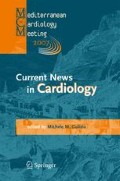Abstract
The electric treatment of cardiac bradyarrhythmias by an implanted pacemaker is mandatory whenever the reduction in ventricular rate results in a functional impairment affecting health, safety, and quality of life [1]. Nevertheless, it is well-known that electrical stimulation of the heart may have disadvantages and drawbacks, which have been progressively identified and brought to attention as a consequence of increasing clinical experience and medical knowledge. Parallel improvements in pacing technology have allowed many essential issues to be addressed and solved, such as the prevention of competitive pacing and synchronization of atrial and ventricular stimulation to maintain physiological sequential activation. In the last decade, the increasing use of biventricular pacing in the therapy of heart failure has underlined the relevance of interventricular and intraventricular synchronization for effective pump function. However, conventional singlesite pacing in the right ventricular apex (RVA) necessarily implies myocardial conduction of the evoked action potential, resulting in deep modification of the ventricular activation pattern and delayed contraction of the left ventricle (LV), as indicated by the altered axis and increased duration of the QRS complex and confirmed by echocardiographic observation. The shortand long-term impacts of RVA pacing on cardiac hemodynamics have therefore become major concerns in the care of patients presenting with bradycardia [2].
Access this chapter
Tax calculation will be finalised at checkout
Purchases are for personal use only
Preview
Unable to display preview. Download preview PDF.
References
Lunati M, Bongiorni MG, Boriani G et al (2005) Linee Guida AIAC 2006 all’impianto di pacemaker, dispositivi per la resincronizzazione cardiaca (CRT) e defibrillatori automatici impiantabili (ICD). Giornale Italiano di Aritmologia e Cardiostimolazione 8(4)
Gillis AM, Chung MK (2005) Pacing the right ventricle: to pace or not to pace? Heart Rhythm 2:201–206
Tse HF, Lau CP (1997) Long-term effect of right ventricular pacing on myocardial perfusion and function. J Am Coll Cardiol 29:744–749
Nunez A, Alberca MT, Cosio FG et al (2002) Severe mitral regurgitation with right ventricular pacing, successfully treated with left ventricular pacing. Pacing Clin Electrophysiol 25:226–230
Sweeney MO, Hellkamp AS, Ellenbogen KA et al (2003) Adverse effect of ventricular pacing on heart failure and atrial fibrillation among patients with normal baseline QRS duration in a clinical trial of pacemaker therapy for sinus node dysfunction. Circulation 107:2932–2937
Nielsen JC, Kristensen L, Andersen HR et al (2003) A randomized comparison of atrial and dual-chamber pacing in 177 consecutive patients with sick sinus syndrome: echocardiographic and clinical outcome. J Am Coll Cardiol 42:614–623
Simantirakis EN, Vardakis KE, Kochiadakis GE et al (2004) Left ventricular mechanics during right ventricular apical or left ventricular-based pacing in patients with chronic atrial fibrillation after atrioventricular junction ablation. J Am Coll Cardiol 43:1013–1018
Lieberman R, Padeletti L, Eastman W et al (2005) Greater sensitivity of cardiac function to ventricular pacing lead location in patients with vs without left ventricular dysfunction. J Am Coll Cardiol 45:100A (abs)
Moro E, Marcon C, Degan P et al (2006) Conventional dual chamber apical pacing in patients with advanced atrio-ventricular block and preserved basal left ventricular function: a prospective long-term study. Giornale Italiano di Aritmologia e Cardiostimolazione 9(4):40 (abs)
Moro E, Marcon C, Sciarra L et al (2006) Long term evaluation of conventional dual chamber pacing in patients with advanced atrio-ventricular block and different hemodynamic configurations. Giornale Italiano di Aritmologia e Cardiostimolazione 9(4):64 (abs)
Melzer C, Sowelam S, Sheldon TJ et al (2005) Reduction of right ventricular pacing in patients with sinus node dysfunction using an enhanced search AV algorithm. Pacing Clin Electrophysiol 28:521–527
Sweeney MO, Ellenbogen KA, Casavant D et al (2005) Multicenter, prospective, randomized safety and efficacy study of a new atrial-based managed ventricular pacing mode (MVP) in dual chamber ICDs. J Cardiovasc Electrophysiol 16:811–847
de Cock CC, Meyer A, Kamp O, Visser CA (1998) Hemodynamic benefits of right ventricular outflow tract pacing: comparison with right ventricular apex pacing. Pacing Clin Electrophysiol 21:536–541
Mera F, DeLurgio DB, Patterson RE et al (1999) A comparison of ventricular function during high right ventricular septal and apical pacing after His-bundle ablation for refractory atrial fibrillation. Pacing Clin Electrophysiol 22:1234–1239
Tse HF, Yu C, Wong KK et al (2002) Functional abnormalities in patients with permanent right ventricular pacing: the effect of sites of electrical stimulation. J Am Coll Cardiol 40:1451–1458
Deshmukh P, Casavant DA, Romanyshyn M, Anderson K (2000) Permanent, direct His-bundle pacing: a novel approach to cardiac pacing in patients with normal His-Purkinje activation. Circulation 101:869–877
Doshi RN, Daoud EG, Fellows C et al (2005) Left ventricular-based cardiac stimulation post AV nodal ablation evaluation (the PAVE study). J Cardiovasc Electrophysiol 16:1160–1165
Hay I, Melenovsky V, Fetics BJ et al (2004) Short-term effects of right-left heart sequential cardiac resynchronization in patients with heart failure, chronic atrial fibrillation, and atrioventricular nodal block. Circulation 110:3404–3410
Di Gregorio F, Morra A, Finesso M, Bongiorni MG (1996) Transvalvular impedance (TVI) recording under electrical and pharmacological cardiac stimulation. Pacing Clin Electrophysiol 19:1689–1693
Bongiorni MG, Soldati E, Arena G et al (2005) Haemodynamic assessment by transvalvular impedance recording. In: Gulizia MM (ed) Emerging pathologies in cardiology. Springer, Milan, pp 323–330
Gasparini G, Curnis A, Gulizia M et al (2005) Rate-responsive pacing regulated by cardiac haemodynamics. Europace 7:234–241
Author information
Authors and Affiliations
Editor information
Editors and Affiliations
Rights and permissions
Copyright information
© 2007 Springer-Verlag Italia
About this paper
Cite this paper
Neri, G., Zamprogno, R., Vaccari, D., Masaro, G., Barbetta, A., di Gregorio, F. (2007). Hemodynamic Optimization of Pacing Configuration in Bradyarrhythmias. In: Gulizia, M.M. (eds) Current News in Cardiology. Springer, Milano. https://doi.org/10.1007/978-88-470-0636-2_38
Download citation
DOI: https://doi.org/10.1007/978-88-470-0636-2_38
Publisher Name: Springer, Milano
Print ISBN: 978-88-470-0635-5
Online ISBN: 978-88-470-0636-2
eBook Packages: MedicineMedicine (R0)

